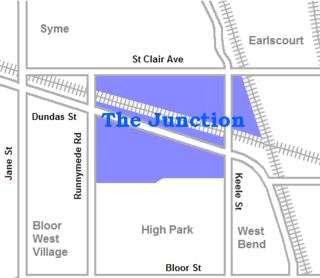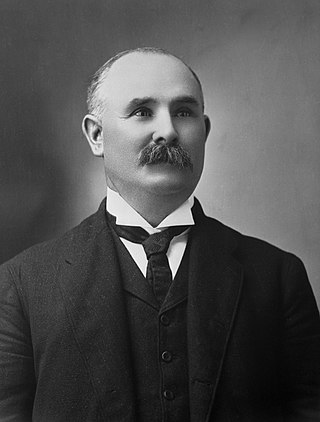
The Junction is a neighbourhood in Toronto, Ontario, Canada, that is near the West Toronto Diamond, a junction of four railway lines in the area. The neighbourhood was previously an independent city called West Toronto, that was also its own federal electoral district until amalgamating with the city of Toronto in 1909. The main intersection of the area is Dundas Street West and Keele Street. The Stockyards is the northeastern quadrant of the neighbourhood.

A feedlot or feed yard is a type of animal feeding operation (AFO) which is used in intensive animal farming, notably beef cattle, but also swine, horses, sheep, turkeys, chickens or ducks, prior to slaughter. Large beef feedlots are called concentrated animal feeding operations (CAFO) in the United States and intensive livestock operations (ILOs) or confined feeding operations (CFO) in Canada. They may contain thousands of animals in an array of pens.

The meat-packing industry handles the slaughtering, processing, packaging, and distribution of meat from animals such as cattle, pigs, sheep and other livestock. Poultry is generally not included. This greater part of the entire meat industry is primarily focused on producing meat for human consumption, but it also yields a variety of by-products including hides, dried blood, protein meals such as meat & bone meal, and, through the process of rendering, fats.

Gustavus Franklin Swift, Sr. was an American business executive. He founded a meat-packing empire in the Midwest during the late 19th century, over which he presided until his death. He is credited with the development of the first practical ice-cooled railroad car, which allowed his company to ship dressed meats to all parts of the country and abroad, ushering in the "era of cheap beef." Swift pioneered the use of animal by-products for the manufacture of soap, glue, fertilizer, various types of sundries, and even medical products.

The Union Stock Yard & Transit Co., or The Yards, was the meatpacking district in Chicago for more than a century, starting in 1865. The district was operated by a group of railroad companies that acquired marshland and turned it into a centralized processing area. By the 1890s, the railroad capital behind the Union Stockyards was Vanderbilt money. The Union Stockyards operated in the New City community area for 106 years, helping Chicago become known as the "hog butcher for the world," the center of the American meatpacking industry for decades. The yards became inspiration for literature and social reform.

Maple Leaf Foods Inc. is a Canadian multinational consumer-packaged meats and food production company. Its head office is in Mississauga, Ontario.

JBS USA Holdings, Inc. is a meat processing company and a wholly owned subsidiary of the Brazilian multinational JBS S.A. The subsidiary was created when JBS entered the U.S. market in 2007 with its purchase of Swift & Company.

Niagara is a neighbourhood in Toronto, Ontario, Canada, located south of Queen Street West; it is usually bordered by Strachan Avenue to the west, Bathurst Street to the east, and the railway corridor to the south, and so named because Niagara Street runs through the centre of it. The eastern portion of this area was first planned as the New Town Extension when Toronto was incorporated as a city. The area was developed as a residential area for the workers of industries located along the CN and CP railway corridors. It remains a working-class neighbourhood that has seen the development of new condominium apartment buildings.

Patrick Burns was a Canadian rancher, meat packer, businessperson, senator, and philanthropist. A self-made man of wealth, he built one of the world's largest integrated meat-packing empires, P. Burns & Co., becoming one of the wealthiest Canadians of his time. He is honoured as one of the Big Four western cattle kings who started the Calgary Stampede in Alberta in 1912.

The Packers and Stockyards Act of 1921 regulates meatpacking, livestock dealers, market agencies, live poultry dealers, and swine contractors to prohibit unfair or deceptive practices, giving undue preferences, apportioning supply, manipulating prices, or creating a monopoly. It was enacted following the release in 1919 of the Report of the Federal Trade Commission on the meatpacking industry.
The Canadian Meat Council is Canada's national trade association for the federally inspected meat packers and processors. It is an industry trade group associated with the meat packing industry. Federally inspected plants account for over 90% of all the meat processed in Canada.

The Union Stockyards of Omaha, Nebraska, were founded in 1883 in South Omaha by the Union Stock Yards Company of Omaha. A fierce rival of Chicago's Union Stock Yards, the Omaha Union Stockyards were third in the United States for production by 1890. In 1947 they were second to Chicago in the world. Omaha overtook Chicago as the nation's largest livestock market and meat packing industry center in 1955, a title which it held onto until 1971. The 116-year-old institution closed in 1999. The Livestock Exchange Building was listed on the National Register of Historic Places in 1999.

Ractopamine is an animal feed additive used to promote leanness and increase food conversion efficiency in farmed animals in several countries, but banned in others. Pharmacologically, it is a phenol-based TAAR1 agonist and β adrenoreceptor agonist that stimulates β1 and β2 adrenergic receptors. It is most commonly administered to animals for meat production as ractopamine hydrochloride. It is the active ingredient in products marketed in the US as Paylean for swine, Optaflexx for cattle, and Topmax for turkeys. It was developed by Elanco Animal Health, a former division of Eli Lilly and Company.
Beef rings are cooperative groups of six to twenty-four farms, with each member of the cooperative being required to supply one animal over the course of the summer to the cooperative for slaughter they are either done locally on the farm or at a slaughterhouse at the member's expense.
Cargill Meat Solutions is a subsidiary of the Minneapolis-based multinational agribusiness giant Cargill Inc, that comprises Cargill's North American beef, turkey, food service and food distribution businesses. Cargill Meat Solutions' corporate office is located in Wichita, Kansas, United States. Jody Horner is the division's president.
William Davies Company was a pork processing and packing company in Toronto, Ontario, Canada. At one time, it was the largest pork packer in the British Empire, and it operated Canada's first major chain of food stores. One of Toronto's longstanding nicknames, "Hogtown", is attributable to the millions of pigs processed annually by the William Davies Company.
National City was a suburb of East St. Louis, Illinois. Incorporated in 1907, it was a company town for the St. Louis National Stockyards Company. In 1996, the company, which owned all residential property in the town, evicted all of its residents. The following year, because it had no residents, National City was dissolved by court order. Its site was subsequently annexed by nearby Fairmont City, Illinois.

Peameal bacon is a wet-cured, unsmoked back bacon made from trimmed lean boneless pork loin rolled in cornmeal. It is found mainly in Ontario. Toronto pork packer William Davies, who moved to Canada from England in 1854, is credited with its development.

The Foreign Cattle Market, Deptford (1872–1913) was one of the two great livestock markets of London; from it came about half the capital's supply of freshly killed meat. Situated at the former royal Deptford Dockyard on a bend of the River Thames and owned by the City of London, all animals came from overseas, were landed by cattle boat, kept under quarantine conditions, and had to be slaughtered within 10 days of disembarkation. None could leave the market alive: the purpose was to stop the importation of animal diseases. Besides cattle, the market handled sheep, pigs and a few others. It could shelter 8,500 cattle and 20,000 sheep at a time, and had 70 slaughterhouses.













